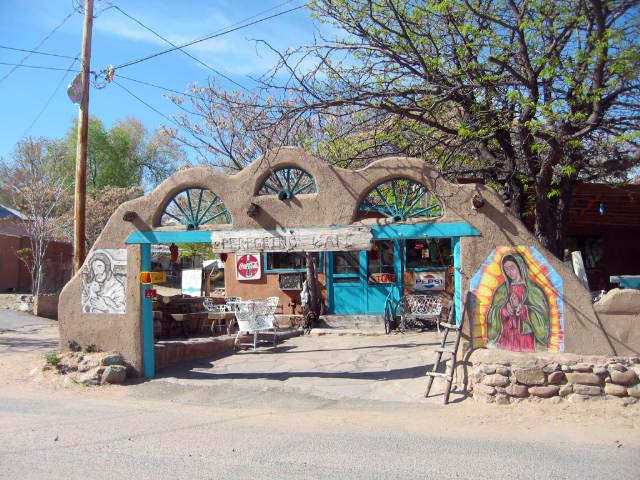April 2006 - Santa Fe New Mexico
El Santuario de Chimayó is a Roman Catholic church in Chimayó, This shrine, a National Historic Landmark, is famous for the story of its founding and as a contemporary pilgrimage site.
In the early 19th Century, nineteen families lived in what was then called El Potrero de Chimayó (potrero means pasture). The land where the Santuario now stands belonged to Don Bernardo Abeyta, one of the first members of Los Hermanos de la Fraternidad Piadosa de Nuestro Padre Jesús Nazareno (the Penitentes) in the area.
Bernardo Abeyta built a small chapel to the Christ of Esquipulas on the present site around 1810. On November 15, 1813, he wrote to Father Sebastián Álvarez, the parish priest of Santa Cruz de la Cañada , asking him to write to the Episcopal See of Durango for permission to build a bigger church in which the people of El Potrero could worship Jesus as he appeared at Esquipulas and could hear Mass. The next day, Fr. Álvarez wrote the letter, mentioning that cures were reported and many pilgrims were arriving. On February 8, 1814, Francisco Fernández Valentín, Vicar General of the Diocese of Durango, wrote back with permission. By 1816 the chapel was replaced by the present church.
Abeyta's daughter, Carmen Abeyta de Chaves, inherited the property and kept it despite an attempt to force her to give it to the Church; a major source of her income was donations from pilgrims. Her daughter, María de los Ángeles Chaves, inherited it in turn and was the owner as of 1915. In 1929, when the owners were in financial trouble, members of the newly formed Spanish Colonial Arts Society bought the property and donated it to the Archdiocese of Santa Fe.
El Santuario de Chimayó is a Roman Catholic church in Chimayó, This shrine, a National Historic Landmark, is famous for the story of its founding and as a contemporary pilgrimage site.
In the early 19th Century, nineteen families lived in what was then called El Potrero de Chimayó (potrero means pasture). The land where the Santuario now stands belonged to Don Bernardo Abeyta, one of the first members of Los Hermanos de la Fraternidad Piadosa de Nuestro Padre Jesús Nazareno (the Penitentes) in the area.
Bernardo Abeyta built a small chapel to the Christ of Esquipulas on the present site around 1810. On November 15, 1813, he wrote to Father Sebastián Álvarez, the parish priest of Santa Cruz de la Cañada , asking him to write to the Episcopal See of Durango for permission to build a bigger church in which the people of El Potrero could worship Jesus as he appeared at Esquipulas and could hear Mass. The next day, Fr. Álvarez wrote the letter, mentioning that cures were reported and many pilgrims were arriving. On February 8, 1814, Francisco Fernández Valentín, Vicar General of the Diocese of Durango, wrote back with permission. By 1816 the chapel was replaced by the present church.
Abeyta's daughter, Carmen Abeyta de Chaves, inherited the property and kept it despite an attempt to force her to give it to the Church; a major source of her income was donations from pilgrims. Her daughter, María de los Ángeles Chaves, inherited it in turn and was the owner as of 1915. In 1929, when the owners were in financial trouble, members of the newly formed Spanish Colonial Arts Society bought the property and donated it to the Archdiocese of Santa Fe.

























We have been here several times and have collected the holy dirt. I have dispensed the dirt to my friends and family who have been sick and they were very grateful.
ReplyDeleteoh, i enjoy all the earth tones ... so pretty. ( :
ReplyDeletei see those type of candles often ... who does not love candles??!
A place I would like to visit, have heard about it. Over come evil with good - amen.
ReplyDeleteWhat a nice tour of this holy place that you gave us!
ReplyDelete